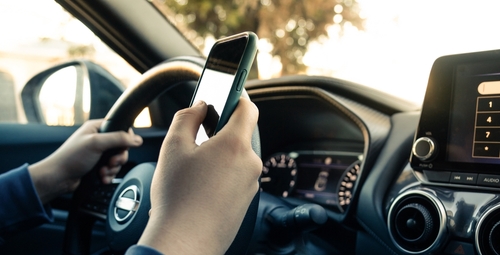This is a common situation a lot of drivers find themselves in. They’re on the road, and then they look over and see the driver next to them texting away on their cell phone. Talk about dangerous. This driver has their eyes focused on the cell phone and not what’s happening on the road. Another common situation is someone’s talking on their cell phone while driving. Both of these are considered distracted driving, and they’re very dangerous. If you’ve been injured by a distracted driver, a car accident lawyer can help you get the financial compensation you deserve.
At Shapiro, Washburn & Sharp, we can evaluate your case and determine your best legal options for recovering damages. Call us today at 833-997-1774 for a free consultation.
How Does Texting and Driving Affect a Car Accident Claim?
Texting while driving is a dangerous distraction that can significantly increase the risk of car accidents. When a driver is texting, their attention is diverted from the road, and they are less able to react to changing conditions, such as sudden stops, obstacles, or other vehicles. This creates a clear liability issue in an accident, as it is generally considered negligent behavior.
In a car accident claim, proving that the other driver was texting can be critical to establishing fault. If the at-fault driver was texting at the time of the accident, they can be held liable for the injuries and damages caused to the other party. In many states, texting while driving is illegal, which strengthens the case against the negligent driver and could lead to higher compensation in personal injury claims.
What Evidence Can Be Used to Prove The At-Fault Driver Was Texting at the Time of the Accident?
Proving that a driver was texting at the time of an accident often requires specific evidence. Here are some of the key pieces of evidence that can be used to establish texting as a cause of the crash:
- Phone records: The most direct evidence is the driver’s phone records, which can show if the driver was texting, sending emails, or using social media at the time of the accident. Law enforcement may be able to subpoena these records, but they will often require a court order. Text message timestamps that align with the accident can show that the driver was distracted at the time of the crash.
- Witness testimony: Eyewitnesses can provide testimony that helps confirm the driver was texting before or during the accident. If any witnesses saw the driver using their phone or swerving as a result of being distracted, their testimony can be valuable.
- Vehicle technology: Many newer vehicles have built-in technology that tracks phone usage and can provide records of incoming or outgoing calls, text messages, or app activity. Some vehicles also have “black box” data that can record the vehicle’s speed, braking, and acceleration patterns, which might indicate erratic driving consistent with distracted driving.
- Police reports: Police officers responding to the scene may investigate whether texting was involved. Their report may include observations or statements made by the at-fault driver, such as admitting they were texting. Additionally, police officers may issue citations for distracted driving or texting while driving, which can further establish liability.
- Surveillance footage: In some cases, surveillance footage from traffic cameras, dashcams, or nearby businesses may show the at-fault driver texting or behaving erratically before the crash. This kind of footage can provide strong evidence to support the claim.
Can the At-Fault Driver’s Phone Records Be Used?
Yes, the at-fault driver’s phone records can be used to prove that they were texting at the time of the accident. However, obtaining phone records often requires legal procedures, such as a subpoena. The phone records may include text messages, call logs, and timestamps that correspond to the time of the accident, helping establish that the driver was distracted by their phone.
Sometimes, the driver may voluntarily provide their phone records, but in other cases, it may require a formal legal request through the court system. It’s important for the injured party to work with an attorney who can help facilitate this process, ensuring that the records are obtained legally and can be introduced as evidence in court.
In addition to phone records, the defendant’s phone may also be examined to check if texting was occurring through applications like social media, messaging apps, or email during the crash.
How Can a Lawyer Help Prove Texting and Driving in a Car Accident Claim?
A lawyer plays a crucial role in helping prove that texting was the cause of a car accident. They will gather all available evidence, including phone records, witness statements, police reports, and surveillance footage. Lawyers can also help obtain necessary subpoenas for phone records and other data that may indicate distracted driving.
An attorney will also work with experts in accident reconstruction, who can use the evidence to demonstrate how the accident happened and how texting contributed to the collision. Expert witnesses can be invaluable in establishing that the distracted driving directly led to the crash, particularly if the at-fault driver tries to argue that other factors were responsible.
An experienced attorney will also negotiate with insurance companies and help ensure that you receive fair compensation for medical bills, lost wages, and other damages resulting from the accident.
How Can Your Law Firm Help?
If you have been injured in an accident caused by a negligent driver, do not delay contacting Shapiro, Washburn & Sharp to speak with one of our skilled car accident attorneys. We will evaluate your case and determine your best legal options for recovering damages caused by the accident.
Call us at 833-997-1774 to schedule a free consultation, and let us help you get the compensation you deserve.
